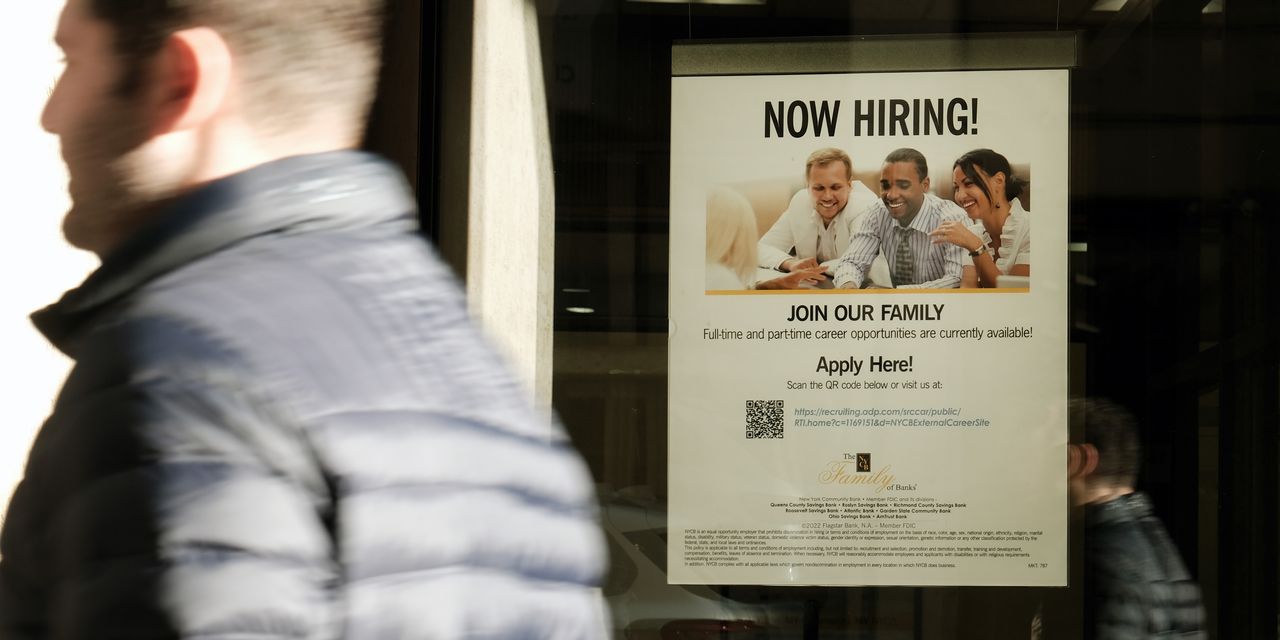The solid employment report for March further raises the odds that the U.S. economy is headed for a proverbial soft landing. But that lowers the chances that inflation will touch down at the Federal Reserve’s elusive target of 2%.
Most important to investors, the jobs numbers suggest the Fed will raise interest rates one more time in this cycle, at the Federal Open Market Committee’s meeting in early May. That’s subject to change, however, based on coming inflation readings or possible repercussions from the recent bank turmoil.
The Bureau of Labor Statistics reported Friday that nonfarm payrolls increased by 236,000 last month, essentially splitting the difference between various surveys of economists that showed estimates of 230,000 or 240,000, depending upon who was canvassing the forecasters. Although robust by historic standards, the payroll rise was the smallest of the postpandemic economic recovery.
The unemployment rate, derived from a separate survey of households, ticked down by one-tenth of a percentage point, to 3.5%, in March. While that was still above the cyclical low of 3.4% reported for January, the jobless rate declined for positive reasons—a sharp rise in both people entering the labor force and finding jobs.
The soft spot in the March establishment data was a 0.1-hour drop in the average workweek, to 34.4 hours, the lowest of the expansion but back in line with the prepandemic workweek. Average hourly earnings continued their moderation with a 0.3% increase in the latest month, in line with the 3.8% annualized gain for the past three months.
But taken as a whole, this was a better-than-good set of jobs numbers released while the stock market was shuttered for Good Friday and bonds and futures had an abbreviated trading session. The data also belied the concerns that followed releases of other labor-market indicators earlier in the week.
The Job Openings and Labor Turnover Survey, or Jolts, for February showed fewer than 10 million unfilled positions for the first time since May 2021. But there were still 1.67 job openings for each unemployed person.
New claims for unemployment insurance turned out to be higher after revisions to recent data. The latest week’s total of 228,000 represented a drop of 18,000 from the previous week. While that is above the sub-200,000 pace reported before the revisions, it still is historically low.
The monthly employment situation depicts a still-tight jobs market that is inconsistent with bringing inflation down to the Fed’s 2% target.
Right now, the economy is enjoying “a bit of an immaculate disinflation,” said Neil Dutta, head of economics at Renaissance Macro Research. “The Fed will welcome that. But the risk is that a soft landing brings about some reflationary dynamics later,” he added in an interview Friday.
For now, the growth of the labor supply has met the demand, according to John Ryding and Conrad DeQuadros, economic advisors at Brean Capital. If labor-force participation had held steady since last November while jobs had expanded at the pace actually seen, the unemployment rate would have dropped from 3.6% to 2.9% over that span.
To be sure, jobs couldn’t have grown that fast without people entering the workforce, but this counterfactual shows just how unsustainably strong employment has been, they wrote in a client note. This growth in the labor force has helped slow the 12-month increase in average hourly earnings to 5.1% from 5.7% in November. But that’s still far above the Fed’s 2% inflation target, they added.
In the shorter term, pay gains have slowed further, to a 3.2% annual rate in the first three months of the year, Dutta said. Assuming productivity is growing at a 1% rate, that would put wage growth at a pace consistent with the Fed’s goal, something that hasn’t been seen for some time, he added.
Dutta thinks the uncertainty posed by the recent regional-bank woes should induce policy makers to pause at the May 2-3 FOMC meeting and hold the Fed’s key federal-funds target at the current 4.75%-5% range, although he says the panel should maintain its tightening bias. That’s contrary to the fed-funds futures pricing of a quarter-percentage-point hike, according to CME FedWatch.
Expectations for Fed policy have swung dramatically since the failure of Silicon Valley Bank early last month, as the nearby chart from Bianco Research shows. Expectations of a half-percentage-point hike were replaced by a quarter-point rise last month amid concerns about the impact of rising rates on bank lending.
As the crisis appears to have abated, expectations of a move to 5%-5.25% in May have revived. That decision is still weeks away with lots more data ahead, notably the March consumer price report due Wednesday.
Ultimately, the March employment report did little to settle the standoff between the Fed and the interest-rate markets. Fed Chairman Jerome Powell & Co. are sticking to their script of one more interest-rate hike, to a median rate of 5.1% by year end.
The markets expect rate cuts starting as early as July, with three reductions to a range of 4.25%-4.50% by December, to counter what they see as a sliding economy ahead of an election year in 2024. In which case, we could be faced with stagflation, should prices and wages remain sticky even after the Fed’s series of sharp rate increases.
Write to Randall W. Forsyth at [email protected]
Read the full article here










